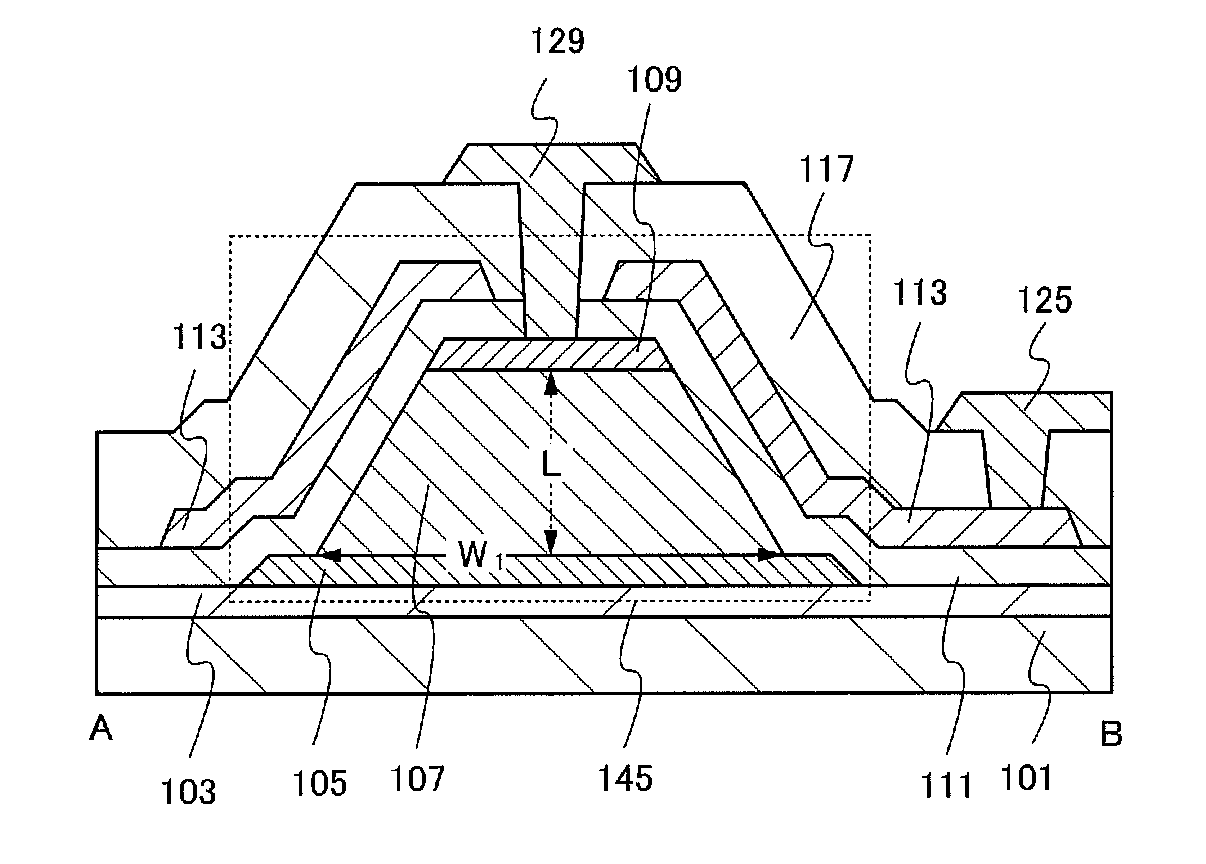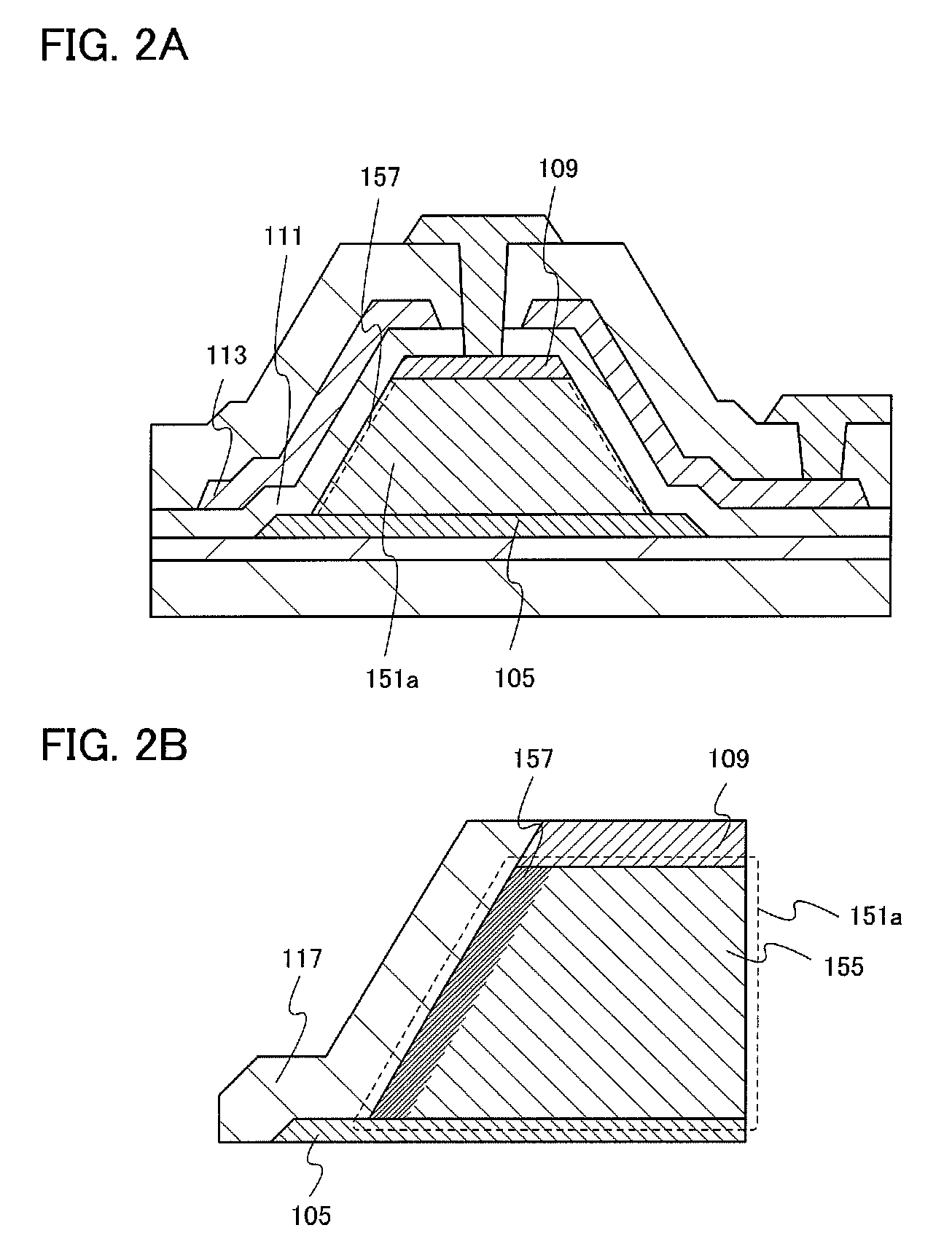Transistor having oxide semiconductor with electrode facing its side surface
a semiconductor and side surface technology, applied in the field of transistors, can solve the problems of difficult melting of silicon carbide, inability to manufacture silicon carbide by a high-productivity method, and defects called micropipes of silicon carbide, so as to achieve favorable operation, reduce the concentration of hydrogen, and increase the purity
- Summary
- Abstract
- Description
- Claims
- Application Information
AI Technical Summary
Benefits of technology
Problems solved by technology
Method used
Image
Examples
embodiment 1
[0044]In this embodiment, a structure of a transistor will be described with reference to FIGS. 1A and 1B.
[0045]FIG. 1A is a top view of a transistor 145, and FIG. 1B corresponds to a cross-sectional view taken along dashed line A-B in FIG. 1A.
[0046]As illustrated in FIG. 1B, a first electrode 105, an oxide semiconductor film 107, and a second electrode 109 are stacked over an insulating film 103 formed over a substrate 101. Note that the second electrode 109 is stacked on and in contact with the entire top surface of the oxide semiconductor film 107. A gate insulating film 111 is provided so as to cover the first electrode 105, the oxide semiconductor film 107, and the second electrode 109. Over the gate insulating film 111, a third electrode 113 is formed so as to face at least side surfaces of the oxide semiconductor film. An insulating film 117 functioning as an interlayer insulating film is provided over the gate insulating film 111 and the third electrode 113. Openings are for...
embodiment 2
[0117]In this embodiment, a structure of a transistor with higher reliability and higher field-effect mobility than those in Embodiment 1 will be described with reference to FIGS. 2A and 2B and FIG. 3.
[0118]In this embodiment, an oxide semiconductor film 151a which is provided between a first electrode 105 and a second electrode 109 as illustrated in FIG. 2A includes a crystal region 157 in a superficial portion. An enlarged view of the vicinity of the interface between the oxide semiconductor film 151a and the gate insulating film 111 is illustrated in FIG. 2B.
[0119]The oxide semiconductor film 151a includes an amorphous region 155 which mainly contains an amorphous oxide semiconductor and the crystal region 157 formed in the superficial portion of the oxide semiconductor film 151a. Note that the superficial portion indicates a region that is located at a distance (depth) from the top surface of 10% or less of the thickness of the oxide semiconductor film.
[0120]Note that the amorph...
embodiment 3
[0130]In this embodiment, transistors with high heat resistance will be described with reference to FIGS. 1A and 1B.
[0131]By using a substrate having a high heat-dissipation property as the substrate 101 illustrated in FIGS. 1A and 1B, a transistor with high heat resistance can be manufactured. Examples of the substrate having a high heat-dissipation property include a semiconductor substrate, a metal substrate, a plastic substrate, and the like. As typical examples of the semiconductor substrate, a single crystal semiconductor substrate such as a silicon substrate or a silicon carbide substrate, a polycrystalline semiconductor substrate, a compound semiconductor substrate such as a silicon germanium substrate, and the like can be given. As typical examples of the metal substrate, an aluminum substrate, a copper substrate, a stainless steel substrate, and the like can be given. As a typical example of the plastic substrate, a plastic substrate containing a carbon fiber, a metal fibe...
PUM
 Login to View More
Login to View More Abstract
Description
Claims
Application Information
 Login to View More
Login to View More - R&D
- Intellectual Property
- Life Sciences
- Materials
- Tech Scout
- Unparalleled Data Quality
- Higher Quality Content
- 60% Fewer Hallucinations
Browse by: Latest US Patents, China's latest patents, Technical Efficacy Thesaurus, Application Domain, Technology Topic, Popular Technical Reports.
© 2025 PatSnap. All rights reserved.Legal|Privacy policy|Modern Slavery Act Transparency Statement|Sitemap|About US| Contact US: help@patsnap.com



